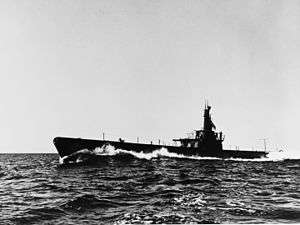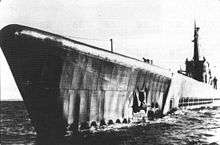USS Capelin (SS-289)
 | |
| History | |
|---|---|
| Builder: | Portsmouth Naval Shipyard, Kittery, Maine[1] |
| Laid down: | 14 September 1942[1] |
| Launched: | 20 January 1943[1] |
| Commissioned: | 4 June 1943[1] |
| Fate: | Missing north of Sulawesi after 2 December 1943[2] |
| General characteristics | |
| Class and type: | Balao-class diesel-electric submarine[2] |
| Displacement: | |
| Length: | 311 ft 9 in (95.02 m) [2] |
| Beam: | 27 ft 3 in (8.31 m) [2] |
| Draft: | 16 ft 10 in (5.13 m) maximum[2] |
| Propulsion: |
|
| Speed: | |
| Range: | 11,000 nm (20,000 km) surfaced at 10 knots (19 km/h)[6] |
| Endurance: |
|
| Test depth: | 400 ft (120 m)[6] |
| Complement: | 10 officers, 70–71 enlisted[6] |
| Armament: |
|
USS Capelin (SS-289), a Balao-class submarine, was the only ship of the United States Navy to be named for the capelin, a small fish of the smelt family. Her keel was laid down by Portsmouth Navy Yard. She was launched on 20 January 1943 sponsored by Mrs. I.C. Bogart, and commissioned on 4 June 1943, Lieutenant Commander E.E. Marshall in command.

Capelin sailed from New London, Connecticut, on 3 September 1943, bound for Brisbane, Australia, and duty with Submarine Force, Southwest Pacific. Her first war patrol, conducted in the Molucca Sea, Flores Sea, and Banda Sea between 30 October and 15 November, found her sinking a 3127-ton Japanese cargo ship on 11 November off Ambon Island.
Capelin returned to Darwin, Australia, with a defective conning tower hatch mechanism, excessively noisy bow planes, and a defective radar tube. These flaws were corrected, and Capelin put out on her second war patrol 17 November 1943, in the Molucca Sea and Celebes Sea, and she was to pay particular attention to Kaoe Bay, Morotai Strait, Davao Gulf, and trade routes in the vicinity of Siaoe Island, Sangi Island, Talaud Islands and Sarangani Island. She was to leave her area at dark 6 December.
Bonefish (SS-223) reported having seen an American submarine on 2 December 1943 in the area assigned to Capelin at that time. The unknown sub quickly dove, probably after sighting Bonefish. Bonefish sent a message via sonar giving Commander Marshall's nickname, 'Steam'. The sub returned an acknowledgement.[7] Following this, Capelin was never heard from again. The Navy broke radio silence on 9 December, but without success.

Japanese records studied after the war listed an attack by minelayer Wakataka on a supposed United States submarine on 23 November, off Kaoe Bay, Halmahera, with the Japanese ship noting the attack produced oily black water columns that contained wood and cork splinters and later a raft was found. This is the only reported attack in the appropriate area at that time. Also, Japanese minefields are now known to have been placed in various positions along the north coast of Sulawesi (Celebes) in Capelin's area, and she may have been lost because of a mine explosion. Gone without a trace, with all her crew, Capelin remains in the list of ships lost without a known cause.
Capelin received one battle star for World War II service. She is credited with having sunk 3,127 tons of shipping on her single war patrol. See also List of U.S. Navy losses in World War II.
References
- 1 2 3 4 Friedman, Norman (1995). U.S. Submarines Through 1945: An Illustrated Design History. Annapolis, Maryland: United States Naval Institute. pp. 285–304. ISBN 1-55750-263-3.
- 1 2 3 4 5 6 7 Bauer, K. Jack; Roberts, Stephen S. (1991). Register of Ships of the U.S. Navy, 1775–1990: Major Combatants. Westport, Connecticut: Greenwood Press. pp. 275–280. ISBN 0-313-26202-0.
- 1 2 3 4 5 Bauer, K. Jack; Roberts, Stephen S. (1991). Register of Ships of the U.S. Navy, 1775–1990: Major Combatants. Westport, Connecticut: Greenwood Press. pp. 275–280. ISBN 978-0-313-26202-9.
- ↑ U.S. Submarines Through 1945 p. 261
- 1 2 3 U.S. Submarines Through 1945 pp. 305–311
- 1 2 3 4 5 6 U.S. Submarines Through 1945 pp. 305–311
- ↑ Holmes, H. (1994). The Last Patrol. Shrewsbury, Eng.: Airlife Pub.
- This article incorporates text from the public domain Dictionary of American Naval Fighting Ships. The entry can be found here.